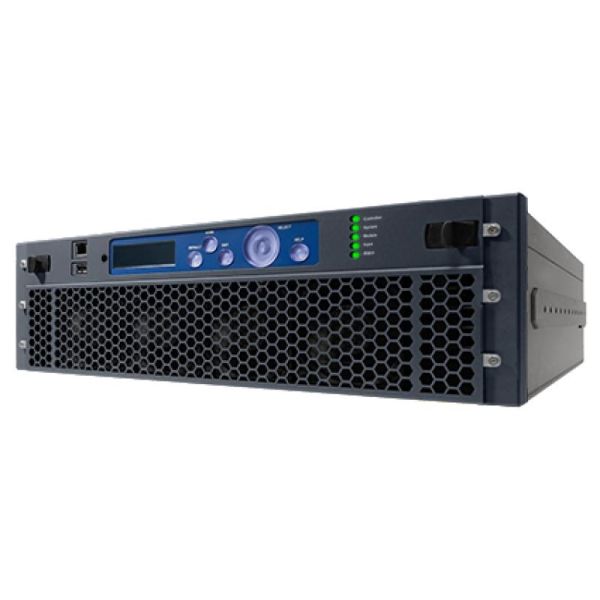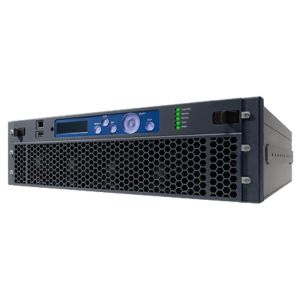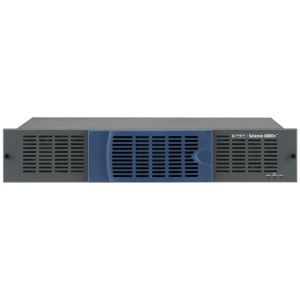Imagine SELOPT-VEX1-EES VIDEO EXPANSION MODULE, HD-BNC INPUTS...
Imagine SELOPT-VEX1-EES VIDEO EXPANSION MODULE, HD-BNC INPUTS AND OUTPUTS; Video expansion module, expansion to FS / XD with single / dual composite analog NTSC / PAL output, includes back module, HD-BNC inputs and outputs
Video expansion module, expansion to FS/XD with single/dual composite analog NTSC/PAL output, includes back module, HD-BNC inputs and outputsThe SELOPT-VEX1-xxx video expansion module sits adjacent to the frame sync and video conversion application modules in the Selenio frame. The video expansion modules provide additional HD-BNC and SFP (fiber optics) inputs and outputs and relay bypass to the Selenio platform. Available versions include HD-BNC input and output, HD-BNC input and output with relay bypass, HD-BNC to SFP optical, SFP optical to HD-BNC, and SFP to SFP.
Features
- Video expansion for Selenio frame sync and video conversion modules
- Optional relay bypass (dual-channel capability)
- Optional SFP for optical input and output
- Can be used as a second thumbnail generator for an 2FS1 or 2XD1 module
Details
When a video expansion module is installed beside a frame sync or video conversion applications module, an automatic connection takes place. The corresponding block diagram in the FS or XD graphical user interface is updated, giving the user setup, control and monitoring functions.
Video and audio signals are connected internally over bidirectional high-speed busses, eliminating external cabling.
When viewing the front of the frame, the video expansion module is added to the left of the frame sync applications module (lower slot number).
Five back module options provide interfaces for electrical and optical inputs and outputs and relay bypass for critical signals upon power loss — one with HD-BNC electrical connections for input and output; one with HD-BNC electrical connections for input and output and dual relays; one with a dual SFP optical input with HD-BNC outputs; one with HD-BNC inputs with two dual SFP optical outputs; and one with a dual SFP optical input and two dual SFP optical outputs.
SDI interfaces utilize a Belden-type 1505A, 1694A or 1695A cable (or equivalent) with HD-BNC connectors. HD-BNC to BNC adaptor cables and a cable insertion/removal tool are available for the HD-BNC connections.
A system design may require additional inputs and outputs for external SDI co-axial and fiber and legacy analog video connectivity with other devices. The VEX eliminates the need for downstream distribution amplifiers when used with a FS or XD module.
Relay Bypass
For critical paths to pass program signals upon loss of power, relay bypass is a requirement. The VEX supports a version for dual replay bypass upon loss of power for use with a dual channel 2FS or 2XD.
Adding Analog Composite Outputs to the Selenio FS/XD Modules
For legacy analog video output from the Selenio, the video expander has two analog composite outputs (NTSC, PAL or PAL-M). The VEX supports 270 Mb/s to analog composite color encoding. For HDTV to analog composite conversion, the VEX is used with the XD module to down convert from 1080p/720p/1080i to 480i/576i for the VEX module to provide conversion to analog composite output. Two HD to analog conversions are possible if the 2XD module is installed beside the VEX module.
Electrical / Optical Interface
The requirement for SDI or Fiber interface input can be easily accomplished with the VEX and FS or XD modules. The VEX can be configured with SFP fiber optic inputs with HD-BNC inputs on the FS/XD for selection of either electrical or optical inputs into the FS and XD video and audio processing. As well, both electrical and optical outputs can be provided.
Specifications
Specifications and designs are subject to change without notice
| SDI Input | |
|---|---|
| Number of Inputs | 1 (-OOS back module) 2 (-EES, -REL, and -EOS back modules) |
| Standard | 1080p (SMPTE 424M) 3G HD-SDI1080i/p (SMPTE 292M) HD-SDI 720p (SMPTE 296M) HD-SDI 525/625 component (SMPTE 259M-C, 270 Mb/s) SD-SDI |
| Frame Rate | 1080i/p/psf: 23.98, 24, 25, 29.97, 30, 50, 59.94, 60 Hz 720p: 50, 59.94, 60 Hz 525/625 |
| Connector | (High-Density) HD-BNC |
| Impedance | 75 ohms |
| Return Loss | >15 dB to1485 MHz >10 dB from 1485 to 2790 MHz |
| Equalization | 3G: Adaptive cable equalization for up to 459 ft (140 m), typical, of Belden 1694A coaxial cable; 328 ft (100 m) for SEL-DDA1-REL version, typical** HD: Adaptive cable equalization for up to 656 ft (200 m) typical, of Belden 1694A coaxial cable; 524 ft (160 m) for SEL-DDA1-REL version, typical** SD: Adaptive cable equalization for up to 984 ft (300 m) typical, of Belden 8281 coaxial cable; 1,312 ft (400 m), typical, of 1694A Belden 1694A coaxial cable** |
| * Support for SMPTE 372M Level B | |
| **Relay bypass HD-BNC connectors are excluded from these equalization specifications. When in bypass mode, the module’s equalization depends on the sensitivity of the downstream device connected to the output of the Selenio DDA relay output. The module equalizes the total length of the sum of the input and output cables that connected to the relay by-passable HD-BNC connectors. | |
| The DDA1 and VEX1 use an extended 3G-reach equalization. When combined with Belden 8281 coaxial cable, a pathological pattern, and a non-SPMTE424 (6.1.7)-compliant signal with excessive output amplitude excursions, the source equalization may be reduced to between 200 and 300 m for SD-SDI signals. This condition typically only occurs with older SD-SDI equipment having a 1uF capacitor on the output. All recent and multi-rate SD/HD/3G equipment is compliant with the standard (having at least a 4.7uF capacitor on the output), and can achieve 300 m with 8281 cable and pathological pattern. | |
| 3G/HD/SD-SDI Output Video | |
|---|---|
| Number of Outputs | 2 (-OOS back module) 4 (-EOS back module) 7 (-OES back module) 8 (-EES and -REL back modules) |
| Standard | 1080p (SMPTE 424M) 3G HD-SDI 1080i/p (SMPTE 292M) HD-SDI 720p (SMPTE 296M) HD-SDI 525/625 component (SMPTE 259M-C, 270 Mb/s) SD-SDI |
| Frame Rate | 1080i/p/psf: 23.98, 24, 25, 29.97, 30, 50, 59.94, 60 Hz 720p: 50, 59.94, 60 Hz 525/625 |
| Connector | (High-Density) HD-BNC |
| Impedance | 75 ohms |
| Return Loss | >15 dB to1485 MHz >10 dB from 1485 to 2790 MHz |
| Signal Level | 800 mV ±10% |
| DC Offset | 0.0 V ±0.5 V |
| Rise and Fall Time | 3G: <135 ps HD-SDI: <270 ps SD-SDI: 400 to 1500 ps |
| Overshoot | <10% |
| Jitter | Timing jitter: 3G HD-SDI: <2 UI pk-to-pk (>10 Hz) HD-SDI: <1 UI pk-to-pk (>10 Hz) SD-SDI: <0.2 UI pk-to-pk (>10 Hz)Alignment jitter: 3G HD-SDI: <0.3 UI pk-to-pk (>100 Hz) HD-SDI: <0.2 UI pk-to-pk (>100 Hz) SD-SDI: <0.2 UI pk-to-pk (>1 kHz) |
SDI Fiber OP+SFP+RR Dual Input Fiber
| Item | Minimum | Typical | Maximum | Note |
|---|---|---|---|---|
| Number of LC Input Connectors | 2 | |||
| Input Wavelength | 1260 nm | 1 | 1620 nm | |
| Optical Power Monitor Accuracy | -2 dB | -2 dB | ||
| Sensitivity at 270 Mb/s (SMPTE 259M) | -22 | -20 | Pathological* | |
| Sensitivity at 1.5 Gb/s (SMPTE 292M) | -22 | -20 | Pathological | |
| Sensitivities at 3 Gb/s (SMPTE 424M) | -20 | -18 | Pathological | |
| Overload | 0 dBm | 2.97 Gb/s* | ||
| *BER = 1E-12 against SDI matrix. Check field signals for video applications. BER = 1E-12 against PRBS 223-1 for datacom applications. | ||||
OP+SFP+TT+1313 Dual Output Transmitter Specifications (-EOS and -OOS Back Modules)
| Item | Minimum | Typical | Maximum | Note |
|---|---|---|---|---|
| Number of LC Connector Outputs | 2x2 | |||
| Standards | 3G: SMPTE 424M HD: SMPTE 292M SD: SMPTE 259M | |||
| Peak Wavelength | 1280 nm | 1310 nm | 1340 nm | Measured at 25C |
| Spectrum Width (RMS) | 1.5 nm | 3 nm | ||
| Average Output Power | -5 dBm | -2 dBm | 0 dBm | |
| Optical Rise/Fall Time (3G HD-SDI) | 105/120 ps | 165/180 ps | ||
| Extinction Ratio | 7 dB | |||
| Jitter | 45 ps | 70 ps | 3 Gb/s Pathological | |
| 60 ps | 100 ps | 1.5 Gb/s Pathological | ||
| 110 ps | 180 ps | 270 MHz Pathological | ||
| Laser Safety Level | Class 1 | |||
| Composite Video Output | |
|---|---|
| Standard | NTSC (SMPTE 170M) PAL-B (ITU 624-2) PAL-M (ITU-R BT.470-6) |
| Connector | (High-Density) HD-BNC |
| Quantization | 12 bits |
| Impedance | 75 ohms |
| Return loss | >40 dB (0.1 to 6 MHz) |
| Frequency response | ±0.2dB, typical (0.1 to 6 MHz) |
| DC offset | <0.0 ±0.005 V |
| Differential gain | <0.5% |
| Differential phase | <0.5 |
| Y/C delay | <10 ns |
| Transient response | <0.5% K Factor |
| SNR | >63 dB typical (luma ramp) (0.1 to 6 MHz) >80 dB typical (Flat field) |
| Module Power Consumption | 40 W maximum |
| Manufacturer | Imagine Communications |
|---|









